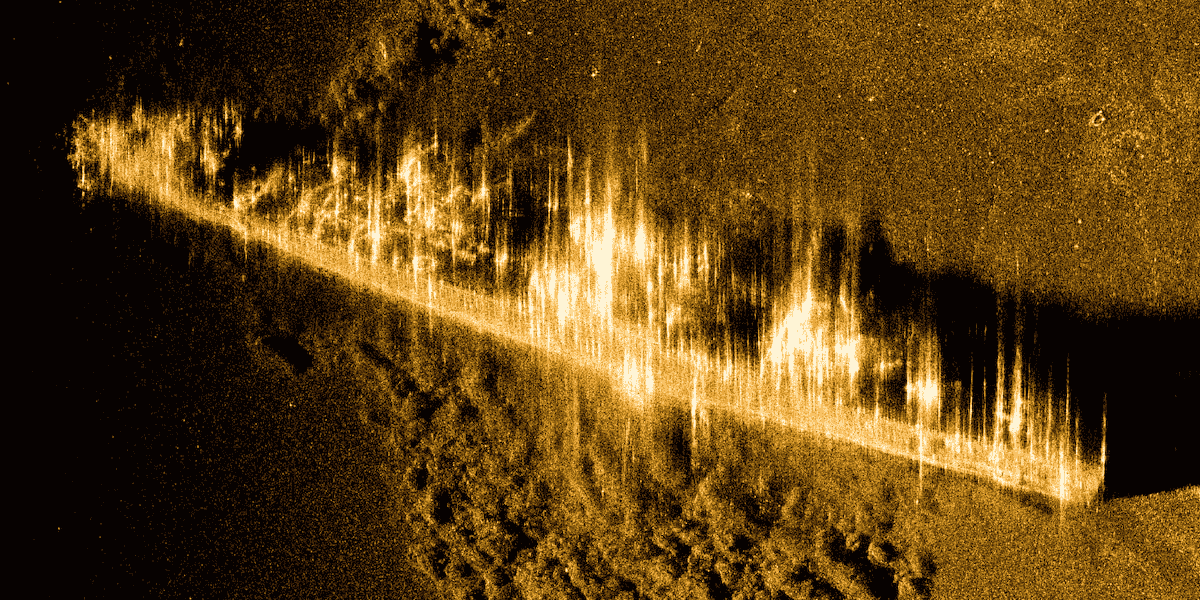In a spectacular discovery, the wreckage of the US Navy’s World War-era warship, USS Edsall—dubbed the “dancing mouse” by its enemies—has finally been found in the depths of the Indian Ocean, more than eighty years after it sank fighting the Japanese forces.
USS Edsall, a Clemson-class destroyer, was sunk in the Pacific Ocean about 200 miles (or over 321 kilometers) off Australia’s Christmas Island on March 1, 1942, following an attack by the Japanese forces. The discovery of the ship was announced by the United States and Australia on the occasion of Remembrance Day, which is commemorated on November 11.
The US Ambassador to Australia, Caroline Kennedy, said in a statement: “The Royal Australian Navy recently located and helped identify the USS Edsall, a World War II, Clemson-class destroyer that was sunk off the coast of Australia in March 1942. Captain Joshua Nix and his crew fought valiantly, evading 1,400 shells from Japanese battleships and cruisers before being attacked by 26 carrier dive bombers, taking only one fatal hit. There were no survivors.”
Speaking alongside Kennedy, Australia’s navy chief, Vice Adm. Mark Hammond, said the wreck was discovered using the naval support ship MV Stoker’s sophisticated hydrographic survey capabilities. The US and Australian navies reportedly located, examined, and identified the ship using robots and underwater drones.
Though extremely significant, the discovery may have been an accident. According to some accounts, the Royal Australian Navy discovered ship debris near Christmas Island while on a secret expedition. At first, surveyors did not know what the wreckage was, but an elaborate investigation revealed that it was the elusive USS Edsall. The EurAsian Times could not independently verify these claims.

The discovery has been attributed to the growing partnership between the US and Australia as part of the AUKUS Alliance. The US chief of naval operations, Adm. Lisa Franchetti said, “A key component of AUKUS is the development of the most cutting-edge underwater technologies of the type that enabled the discovery of Edsall in the vastness of the Indian Ocean, something not possible just a few years ago.”
“The wreck of this ship is a hallowed site, serving as a marker for the 185 U.S. Navy personnel and 31 U.S. Army Air Force pilots aboard at the time, almost all of whom were lost when Edsall succumbed to her battle damage,” Chief of Naval Operations Adm. Lisa Franchetti said in a statement. “This find gives us the opportunity for today’s generation of sailors and Navy civilians to be inspired by their valor and sacrifice.”
The Edsall is the latest World War II vessel to be discovered after being lost to the ocean for over eight decades. As earlier reported by EurAsian Times, the wreckage of the USS Harder, America’s most lethal submarine during World War II, was located off the coast of Luzon, Philippines, in May 2024, after eighty years.
After the discovery of USS Edsall was announced, some referred to it as a “closure” for hundreds of families that lost their loved ones when the ship sank.
EurAsian Times dives back in history to recount what led to the sinking of the USS Edsall.
The USS Edsall In Combat
Though the USS Edsall sank in 1942, it was launched long before World War II commenced.
Commissioned in 1920, the USS Edsall was named after Seaman Norman Edsall, a sailor killed during the Spanish-American War. Initially, the warship was deployed to protect American ships and rescue refugees in the Mediterranean, but eventually, it was tasked with protecting American interests in the Far East for a long time. The battleship served during the early stages of the Sino-Japanese War and the Chinese Civil War.
Then came the Second World War.
Japan participated in the war from 1939 to 1945 as part of the Axis powers, which included Nazi Germany and Fascist Italy. However, even though the United States began providing significant military supplies and other assistance to the Allies in September 1940, it did not formally enter the war until December 1941, when Japan launched the Pearl Harbor attack.
The USS Edsall was on its way to Jakarta when the Pearl Harbor attack was launched. It regrouped and quickly joined other American vessels in the Pacific. For weeks, it was tasked with protecting ships off the coast of Australia. Edsall and its sister ships performed exceptionally well.

In fact, the ship fought a string of battles to protect Australia from the Japanese. One of these was the Battle of Coral Sea, fought in May 1942, which the Australian Navy Chief also hailed in the latest announcement about the ship’s discovery.
Edsall fought valiantly in this battle, aimed at thwarting Japanese attempts to occupy Port Moresby in New Guinea and Tulagi in the southeastern Solomon Islands—both in the Pacific and close to Australia. Edsall played a crucial role in this battle and sank Japanese submarine I-124, marking the first-ever instance of a US warship involved in the loss of an enemy submarine in the war.
As per historical records, the USS Edsall gave the enemy a hard time until its last battle.
The Last Battle: D-Day For USS Edsall
On the D Day—March 1, 1942—Edsall was on course to a sunken Allied oil ship about 225 miles (362 kilometers) off Christmas Island. Alone on this short mission, the warship was detected by the Japanese and soon came under fire from two cruisers and two battleships.
By this time, Vice Admiral Chūichi Nagumo, who had spearheaded the attack on Pearl Harbor, was in charge of Japanese forces. Nagumo was allegedly “incensed” that the US warship was spotted within 16 miles of his forces and gave them explicit instructions to hunt the ship down.
Fearless as he was, Edsall’s captain, Joshua Nix ordered his ship to fight back. However, with larger weapons and hundreds of planes carrying 500-pound bombs, the Japanese fleet would prove too formidable for the old US destroyer Edsall and its 4-inch guns.
“Nix’s position was hopeless from the moment Edsall was sighted.” However, he refused to give up, wrote Samuel Cox, the Director of the US Naval History and Heritage Command (NHHC). “As a last gesture of defiance, like the famous cartoon of the little mouse flipping the bird at a huge screaming eagle, Lieutenant Nix chose to make a fight of it.”
Despite being outnumbered and against the massive odds that prevailed, the USS Edsall didn’t sink easily. The Edsall maneuvered quickly to dodge hostile fire as it swerved through the water. It managed to escape over 1,300 enemy shells. In the face of that great adversity, the ship’s crew used smoke as cover because they were outnumbered and outgunned.
According to Cox’s account, drawn from Japanese sources, Japanese commanders ordered hundreds of dive bombers from their three aircraft carriers to strike after Edsall eluded more than a thousand 14-inch and 8-inch shells.
Eventually, Edsall was struck by at least one, and the ship’s maneuverability deteriorated.
In his final act of defiance, Nix directed the ship to be abandoned while the ship was settling and lost direction due to the roaring fires. After that, the Japanese warships fired their large guns at the crippled destroyer, ultimately sinking it.

As seen in a photograph (see above) from the time, the ship continued to fight even as it was drifting inside the ocean.
The struggle claimed the lives of the majority of the crew, while some others were captured by the Japanese soldiers. Mass graves later found in Indonesia showed prisoners were decapitated. As per official records, 186 American crew died in the sinking of Edsall.
Cox said that Japanese witnesses respected Nix’s strategies and courage. A Japanese witness claimed that Edsall’s performance resembled that of a “Japanese dancing mouse,” a common domesticated pet in Japan that is referred to as a “whirler” or “waltzing mouse” due to its erratic and odd motion. Cox described the Edsall incident as “one of the most gallant and valorous actions in the history of the U.S. Navy.”
USS Edsall’s last battle and Nix’s bravery live on in the United States as legends of its formidable naval history. This was evident in the statement of the US chief of naval operations, Adm. Lisa Franchetti: “The commanding officer of Edsall lived up to the U.S. Navy tenet, ‘Don’t give up the ship,’ even when faced with overwhelming odds.”
- Contact the author at sakshi.tiwari9555 (at) gmail.com
- Follow EurAsian Times on Google News




